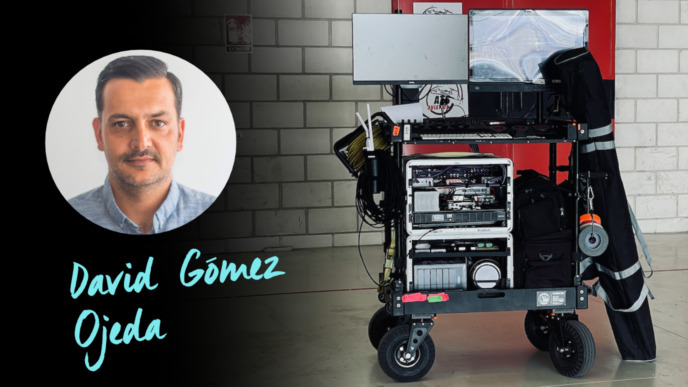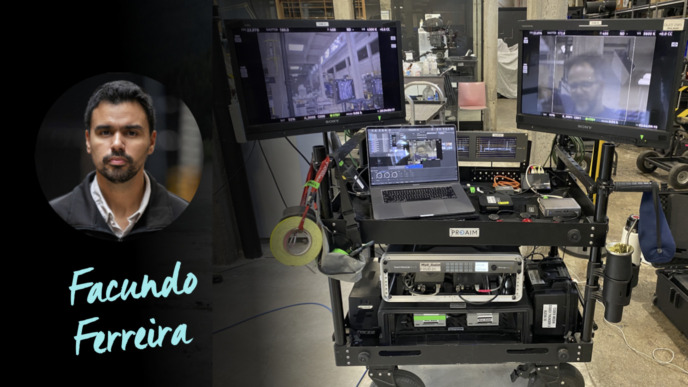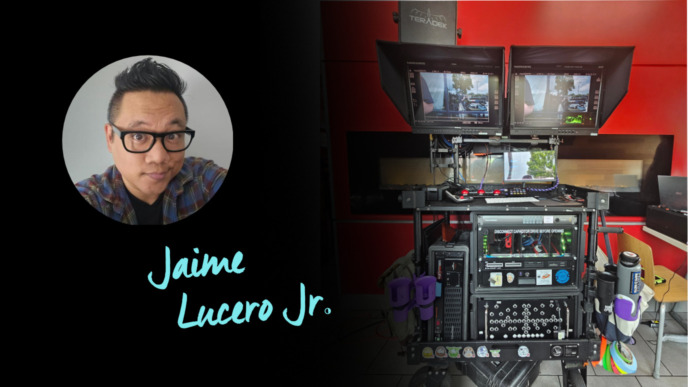
Contrary to the global trend of customizing DIT carts, most French DITs rent equipment for each show. In this article, we got to speak with French DIT and President of the French Professional Association of Digital Imaging Technicians (ADIT) Audrey Samson.
Audrey has been the president of ADIT since 2021. This group brings together many French-speaking DITs, data managers, video operators, and phantom operators, serving as a rich networking resource within the industry. They foster close relationships with other professional associations and companies related to the field with whom they participate in several industry exhibitions.
For each show, Audrey rents equipment from the French company Be4Post. Later in the interview, Audrey talks about the benefits of renting her equipment, but first, we asked Audrey to tell us more about herself and how she came into the role of DIT.

Audrey: I began my career in 2010 at a post-production company called Digimage Cinéma, where I recieved training in image processing-related roles. Initially, my tasks involved quality control, creating DCPs, TV mastering, scanning rushes, and conforming. Over the years, I transitioned to other post-production companies such as Mikros and Technicolor Paris.
During this time, I shifted my focus toward assisting in color grading and became involved in grading rushes. Therefore, It was a natural progression for me to move into the role of a digital imaging technician, which allows me to work closely with the DP. The DIT is a position I have been dedicated to since 2016.
I usually work on series for Netflix, Amazon, or Apple TV since the demand for DITs on streaming series has increased since 2020.
Overall, how would you describe your typical DIT setup?
Audrey: My setup is tailored to the collaborative needs of whichever DP I work with. In the context of my role, which involves maintaining a close connection with the DP, I often work directly with RAW footage, and color grade dailies on set to achieve the desired final looks.

This ensures that the DP’s vision is accurately translated into the initial viewing, with the color-graded proxies sent promptly to the nearby editor. Additionally, for commercial projects, I conduct on-set color grading and apply the CDL to the dailies, facilitating a seamless integration of the intended visual style from the outset.
Basic Setup
Could you please walk us through the bits and pieces of your overall setup?
Audrey: I work with a French rental company called Be4Post. They have all I need to work on a DIT cart.
I always use the smallest and strongest setup possible, and it must have wheels so it can move around. Innovation Carts are the best solution to fit my needs, I use the INOVATIV Echo Cart 36 and sometimes the Echo 30.

On the top of my cart, I have two screens: A computer screen, and a calibrated OLED monitor.
I use a high-performance workstation or laptop, depending on the project’s requirements. I always incorporate color grading software, like Livegrade Pro, data management solutions like Silverstack XT, and monitor calibration equipment for precise image processing. Both Livegrade Pro and Silverstack XT are paired with Stream Deck for shortcuts.
My power supply varies per project. If my setup is movable, I take batteries like Maluna or Bebob with their Cube 1200.
I use the Pelsue Umbrella Tent for on-set work. This enhances my ability to maintain consistent lighting conditions and ensures optimal visibility and color accuracy during digital imaging processes.
Cart Variations
Audrey: I configure my equipment with Be4Post for each new project. Each project requires me to adapt the cart based on the preferences and the needs of the DP, budget constraints, and set requirements. Consequently, I may not always use the same equipment, especially when it comes to on-set live grading or color grading native rushes. That varies depending on the proximity to the set.
Depending on the project, particularly those where I need to be self-sufficient in terms of power and mobility, I opt for a MacBook Pro equipped with a Pess Energy battery. This setup allows me to work seamlessly for extended periods without any power constraints, ensuring flexibility in my on-set workflows.
If I have a substantial number of proxies to generate at a high processing speed, and the need for independent power arises only later in the day, I would opt for a MacPro 2019, for instance, mounted on a rolling Echo 36 cart. This configuration allows me greater flexibility in my workflow, providing an extended range of work hours while ensuring the necessary power independence when required.
Working with an equipment rental company offers the advantage of increased flexibility and easy adaptation. This arrangement provides the convenience of tailoring resources to specific project needs, ensuring a more seamless and adaptable workflow.

Audrey and Her Cart
What is your favorite part of your setup and why?
My preferred component is the monitoring display. It’s the crucial element in which I place my trust, relying on its technology and output. It serves as the pinnacle of my work, ensuring accuracy and precision throughout the process.
The latest addition to my setup is the Whaley Rail – Monitor Mounting System from Upgrade Innovations. This provides me with enhanced flexibility in attaching screens and enabling smooth mobility with my rolling cart. This system ensures ease of use and convenience in adapting to various on-set requirements.
We know that the nature of the DIT role requires you to be on set for long periods of time day after day. Is there anything you do to stay healthy both mentally and physically while on set?
I build positive relationships with colleagues. From them, I receive emotional support and create a more enjoyable work environment. I take time to socialize and connect with others during breaks.
Are there any notable stories that have happened with or to your setup that you’d like to share?
As a DIT on film or fiction sets, I often find myself in one of the last positions remaining at the end of the day. It’s not uncommon for me to be alone to finish processes for rushes. I try to stay in the camera truck for more flexibility, but there have been instances where I’ve found myself working in quite unconventional locations such as a crematorium, a psychiatric hospital, or a disused wing of a prison. There’s always a slight anxiety that the rest of the team might forget about me while closing down the set.
Is there anything we haven’t covered that you would like to add?
Since 2021, I’ve been the president of the French Professional Association of DIT, which brings together professional DITs, data managers, video operators, and phantom operators. Currently, the group consists of over 60 members.

We are a French-speaking association, established in 2012, and we provide a platform for our members to exchange experiences, and deepen their knowledge of our ever-evolving professions.
We often organize events in collaboration with other professional associations or companies that are related to the field and actively participate in exhibitions such as IBC, Micro Salon, and the Camerimage Festival. Our association serves as a valuable resource for networking, knowledge sharing, and staying updated on the latest developments in our dynamic profession.
A huge ‘thank you’ to Audrey for sharing your DIT cart setup with us.
Listen to This Article!
You are currently viewing a placeholder content from Spotify. To access the actual content, click the button below. Please note that doing so will share data with third-party providers.
More Information
Audrey Samson, DIT
Embarking on her career in 2010 in the post-production landscape, Audrey honed skills in image processing, including DCP creation, TV mastering, scanning rushes, and conforming. Transitioning across notable post-production houses, she delved into color grading and became a digital imaging technician in 2016. Now specializing as a DIT, she primarily works on projects for platforms like Amazon, Netflix, and Canal +.
IMDb Profile
Website
Instagram Profile



